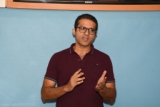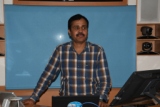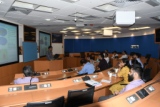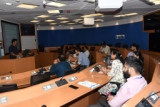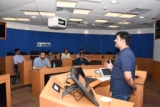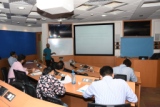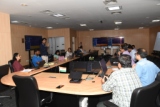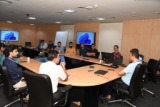ESSO - Indian National Centre for Ocean Information Services
(An Autonomous Body under the Ministry of Earth Sciences, Govt. of India)
Training on Tsunami, storm surge, ocean state and vulnerability mapping to NPCIL Officers
Organized by
International Training Centre for Operational Oceanography (ITCOocean), ESSO-INCOIS,
Hyderabad, India
The course will provide exposure to the officers from Nuclear Power Corporation of India on various operational aspects of Indian Ocean Tsunami Early System, Strom Surge, Ocean State and Vulnerability mapping services operating from INCOIS. NPCIL can use services being generated and disseminated by INCOIS and can utilize specialised online tools developed in house at INCOIS for their operational requirements. This includes the services like Tsunami and Strom surge inundation information, Multi-Hazard Vulnerability, Search And Rescue Aid Tool (SARAT) for operations in the sea, in case of any untoward incidents in the sea; Online Oil Spill Advisory (OOSA) system for providing oil spill trajectory forecast during oil spill incidents. Regular ocean state forecasts (winds, waves, currents, tides) covering the geographical region of their interests is also provided routinely, for their operations.
This training provides a in depth exposure on the hazards occurring along the Indian coasts viz., Indian Tsunami and Early Warning Services (ITEWS), Strom Surges, Multi Hazards that are being provided by INCOIS to India and countries in the Indian Ocean region. This training will be helpful to the officers NPCIL, who are placed in various operations in coastal areas for timely action as necessary. The course is designed to cover observational, modelling aspects along with details description of Standard Operating Procedures (SOPs) followed for timely dissemination of Hazard alerts to nuclear power generation centres for their operations.
At the end of the training participants will be taken to the earth station of INCOIS for witnessing the real-time data acquisition of the EOS-06 OCM-3 data and few other facilities at INCOIS.
- Over view of ITEWS and other Hazard activities.
- Understand the observational data used in Tsunami and hazard services.
- Understanding the decision support systems and SOPs.
- Exposure to Standard Operating Procedures followed at INCOIS.
- To understand the modelling aspects involved in hazard services.
- Knowledge and understanding of ITEWS and other hazard services and products.
- Capability to use the web based hazard services and alerts independently from their centres.
- Handling the specialised service information for operational use if need arise.
- Officers of Nuclear Power Corporation of India Limited.

Only by invitation
4 th - 8th September, 2023
- Dr. TVS Udaya Bhaskar
- Dr. K. Siva Srinivas
- Dr. Dipankar Saika
- Mr. RS Mahendra
- Dr. Hari Kumar
- Sandhya K.G.
- Dr. PLN Murty, IMD, New Delhi

International Training Centre for Operational Oceanography (ITCOocean)
Indian National Centre for Ocean Information Services (INCOIS)
(Ministry of Earth Sciences, Government of India)
"Ocean Valley", Pragathi Nagar (B.O.)
Nizampet (S.O.), HYDERABAD - 500 090
TELANGANA
INDIA
For Any questions please contact:
Dr. T V S Udaya Bhaskar
Head, Ocean Data Management (ODM) & Programme Planning and Coordination Group (PPC)
E-mail: itcoocean@incois.gov.in/uday@incois.gov.in

Training schedule (4 – 8th Sep 2023): Tsunami, storm surge, ocean state and vulnerability mapping
| Time | Day - 1 | Day - 2 | Day - 3 | Day - 4 | Day - 5 |
|---|---|---|---|---|---|
| Opening Session Introduction to Operational Oceanography (Theory) by (Dr. T.V.S. Uday Bhaskar) |
Ocean Forecast, Warning, Advisory and Information Services (Theory) by (Dr. R. Harikumar) |
Introduction to vulnerability mapping approaches (Theory) by (R. S. Mahendra) |
Significance/role of input parameters in modeling (Tsunami & Storm)(Theory) by (Dr. Siva Srinivas) |
Theory of wind models: Jelesnianski and Holland by (Dr. Siva Srinivas) |
|
|
Seismo-tectonics of the Sumatra and Makran Regions -Earthquake and Tsunami Hazards in the Indian Ocean (Theory)
by (Dr. Dipankar Saikia) |
Tsunami Modeling Exercise (Hands-on)
by (Dr. Siva Srinivas) |
Generation of the tsunami and storm surge vulnerability maps (Hands-on)
by (R. S. Mahendra) |
Storm Surge modeling using ADCIRC (Hands-on)
by (Dr. PLN. Murty, IMD) |
Fundamentals of wave modelling and basics of SWAN model
by (Sandhya K G) |
|
|
Tsunami - Science, Modelling and Early warning (Theory)
by (Dr. Siva Srinivas) |
Tsunami Modeling Exercise (Hands-on)
by (Dr. Siva Srinivas) |
Storm Surge- basics, ADCIRC modeling and early warning (Theory)
by (Dr. Siva Srinivas) |
Different meshing techniques for ADCIRC and effect of bathymetry data on meshing (Theory & Hands-on )
by (Dr. PLN. Murty, IMD) |
|
|
|
Using Modeling for Hazard Assessment: Introduction to Tunami-N2/ADCIRC (Theory)
by (Dr. Siva Srinivas) |
visit to INCOIS facilities
|
Storm Surge modeling using ADCIRC (Hands-on)
by (Dr. Siva Srinivas) |
Different ADCIRC meshing techniques and effect of bathymetry data on meshing (Theory & Hands-on )
by (Dr. PLN. Murty, IMD) |
|
|
- Introduction to Oceanography: tides, winds, currents, wave theory (long and short waves), measurement of ocean parameters (tide gauges, Buoys etc.)
- Tsunami - Science, Modelling and Early warning: Phenomena of Tsunami, theory of shallow water equations.
- Tsunami Modeling Exercise (Hands-on): Includes Pre-processing (meshing), solving and post processing
- Storm Surge modeling using ADCIRC (Hands-on): Includes Pre-processing (meshing), solving and post processing
- Significance/ role of input parameters in modeling (Tsunami & Storm) (Theory): bottom friction coefficients, wave breaking depths and mechanisms, Tidal constants, role of SWELL in storm surges etc.
- Different ADCIRC meshing techniques: Scalar paving, paving, LTEA, fine and coarse mesh control
Photo Gallery






